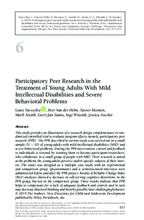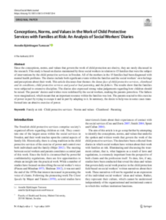Demographic Data:
|
Sources: World Bank, UNDP, DHS 2010-11 |
Displaying 5641 - 5650 of 14348
This chapter highlights the key assumptions underlying Randomized Control Trials (RCTs) and illustrates them with regard to the practice of RCTs in the realm of child and adolescent development.
The purpose of this commentary is to reflect on the utility and possible application of the suggestions and study designs in this special issue to real‐life intervention studies in dynamic context settings.
This study provides an illustration of a research design complementary to randomized controlled trial to evaluate program effects, namely, participatory peer research (PPR). The PPR described in current study was carried out in a small sample (N = 10) of young adults with mild intellectual disabilities (MID) and severe behavioral problems [in residential care in the Netherlands].
This article reports on an exploratory study about maintaining and supporting the cultural identity of children from culturally and linguistically diverse family backgrounds in foster care placements.
This study is based on diaries maintained by three social workers in relation to 15 families that were the subject of interventions by the child protective services in Sweden.
In this article, institutions in Russia, China, Ghana, and Chile are described with reference to the circumstances that lead to children’s institutionalization, resident children’s social-emotional relationships, and unique characteristics of each country’s institutional care (e.g., volunteer tourism in Ghana, and shifting demographics of institutionalized children in China).
The authors of this study conducted research with 234 care experienced university students in England and Wales to explore the factors that promoted access to higher education.
The objective of the study was to examine the level of Resilience and psychological wellbeing among orphan and non-orphan adolescents; and to examine the influence of resilience on psychological wellbeing of orphan and non-orphan adolescents.
This study sought to analyze the executive functions of a sample of 43 Spanish foster children aged between five and nine years (M = 7.51, SD = 1.29), using a caregiver-reported questionnaire.
This study had two aims: first, it sought to test whether Children and young persons (CYPs) who entered residential care with higher level-of-care (LoC) scores on the Child and Adolescent Needs and Strengths (CANS) tool, indicative of higher needs or more intensive services required, were more likely to experience a critical incident. Second, it aimed to test the various needs separately with the occurrence of critical incidents to delineate the impact of each individual need on critical incident.





